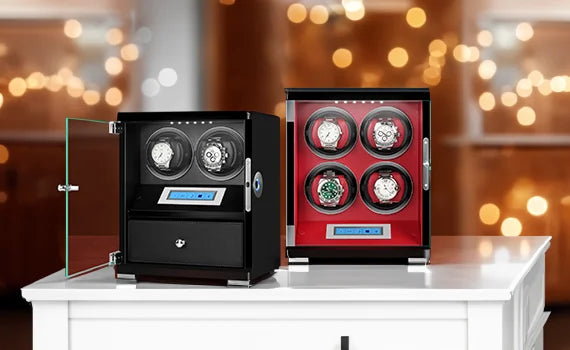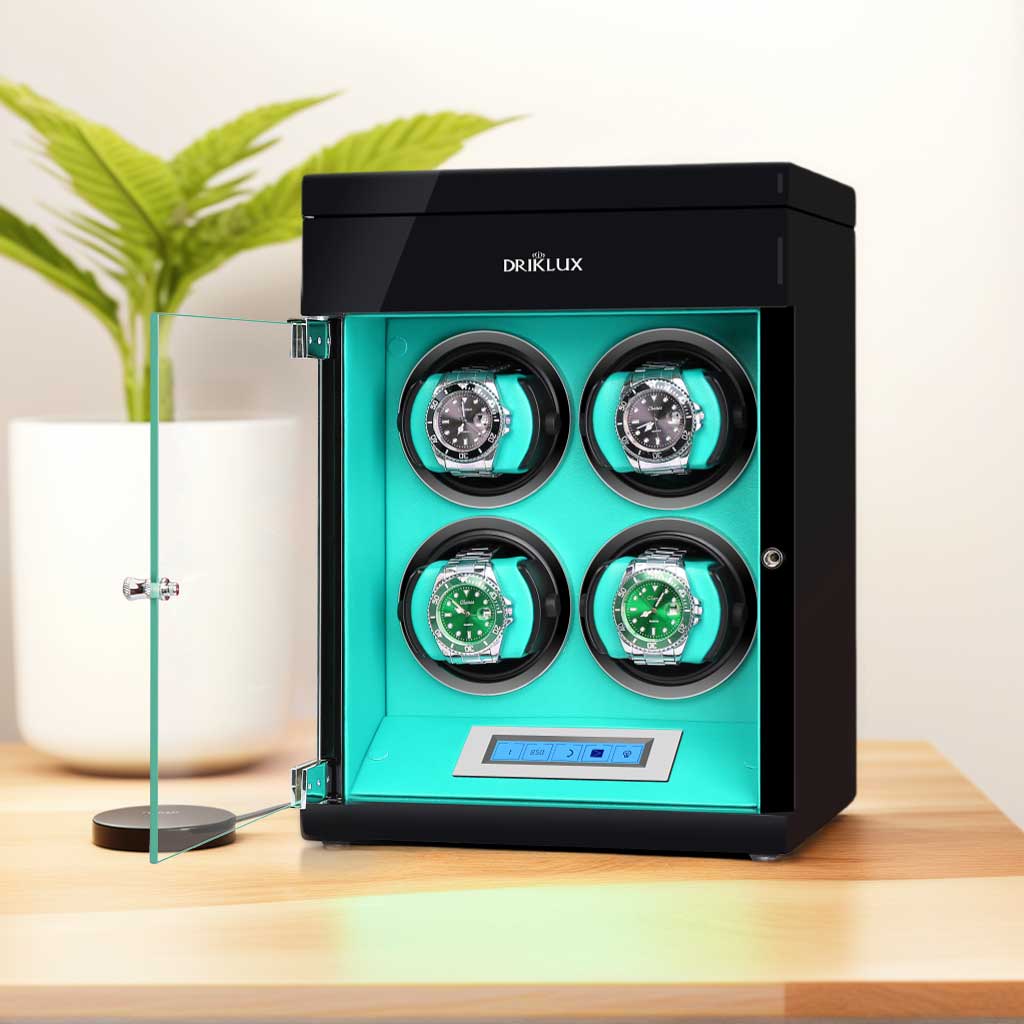Brushless vs. Geared: A Technical Look at Why Driklux Chooses Silent Stepper Motors
When it comes to watch winders, the motor is the heart of the device—directly influencing noise levels, durability, precision, and overall user experience. While many consumers focus on exterior aesthetics and storage capacity, it's the internal motor technology that truly separates premium winders from their budget counterparts. In this technical exploration, we'll examine why Driklux has made a deliberate choice to use silent stepper motor architecture across our premium winder collection, and how this decision impacts the care of your valuable timepieces.
1. Understanding Motor Types in Watch Winders
Traditional Brushed DC Motors with Gears
The most common motor type found in budget-friendly watch winders is the brushed DC motor with a mechanical gear train. This system consists of carbon brushes that make physical contact with a commutator, a simple DC motor that spins at high RPMs, and a gearbox that reduces speed while increasing torque. While this design is inexpensive to manufacture, it introduces multiple points of friction and mechanical wear that can compromise long-term performance.
Brushless Direct-Drive Motors
Brushless motors represent a significant technological advancement, eliminating the physical contact between brushes and commutator. Instead, they use electronic commutation through sophisticated controllers, permanent magnets on the rotor, and stationary windings on the stator. This design reduces friction, heat generation, and mechanical noise while improving efficiency and longevity.
Stepper Motors: Precision in Motion
Stepper motors, particularly brushless stepper implementations, represent the pinnacle of precision for watch winding applications. These specialized motors operate by dividing rotation into precise, discrete steps (typically 200-800 steps per revolution), allowing exact control over angular position. This level of control makes stepper motors ideally suited for the exacting requirements of automatic watch maintenance.
2. The Reality of "Geared" Systems in Watch Winders
In traditional geared watch winders, a small, fast-spinning motor drives a series of gears to achieve the slow, controlled rotation required for watch winding. This gear train typically includes a primary gear on the motor shaft, one or more intermediate reduction gears, and a final drive gear that connects to the watch holder.
While effective for reducing speed and increasing torque, gear trains introduce several potential problems. Noise generation from meshing gears creates audible whine and clicking, while plastic gears—common in budget models—wear unevenly over time. Additionally, backlash between gear teeth can create inconsistent motion, and multiple interfaces compound manufacturing tolerances. These issues explain why geared systems are attractive for budget winders but problematic for quiet, long-term premium applications.
3. How Brushless and Stepper Technologies Work
The Brushless Advantage
Brushless motor technology eliminates the primary wear points found in brushed systems. Electronic commutation replaces mechanical brushes, reducing friction points, heat, and mechanical noise while improving efficiency. Without brush-to-commutator contact, there's less energy lost to friction and heat, resulting in more efficient operation.
Stepper Motor Precision
Stepper motors excel in watch winding applications due to their unique control capabilities. Each electrical pulse results in a precise angular movement, and the motor knows its exact position without feedback systems. This enables programmable motion profiles with complex winding patterns that can be precisely executed.
When applied to watch winding, stepper technology enables exact turns-per-day (TPD) delivery, controlled rotation direction, and programmable rest periods that closely mimic natural wrist motion. This precision is particularly important for luxury timepieces with complex movements.
4. Why Silence Matters for Premium Watch Winders
The noise generated by traditional geared systems can be particularly disruptive in residential environments. Motor hum and gear whine can disrupt sleep patterns when winders are placed in bedrooms, create unwanted noise in office environments, and become intrusive in quiet living spaces. Additionally, noisy operation suggests inferior craftsmanship to discerning collectors.
Brushless stepper motors address these noise concerns through fundamental design advantages. The elimination of meshing gears removes the primary sound source, while solid-state electronic commutation operates silently. Precise step control avoids mechanical vibration, enabling near-silent performance that's ideal for bedside placement.
At Driklux, we've made silent operation a core differentiator because we understand that watch winders often occupy living spaces where noise sensitivity is paramount.
5. Precision and Watch Safety: The Technical Advantages
The precision of stepper motors directly benefits automatic watch maintenance. Each step is precisely controlled, ensuring exact TPD delivery, and there's no speed drift or torque variation over time. Bidirectional rotation can be precisely programmed, and exact pause timing mimics natural wearing patterns.
This precision prevents both under-winding (insufficient power reserve) and over-rotation (unnecessary wear) for sensitive automatic movements. Stepper motor technology enables sophisticated winding profiles that protect your watches through soft start/stop capabilities, controlled speed consistency, and gentle motion that helps maintain even lubricant distribution without stress.
In contrast, low-end geared drives may experience speed variations and torque inconsistencies that make fine calibration less reliable over time.
6. Durability, Maintenance, and Efficiency Considerations
Geared brush motors contain multiple components that degrade over time. Carbon brushes gradually wear down, requiring replacement; electrical contacts can pit and corrode; plastic gears develop uneven wear patterns; and mechanical bearings accumulate wear and play. These wear points lead to increasing noise, reduced performance, and eventual failure.
Brushless stepper designs eliminate many of these failure modes. Electronic commutation eliminates the primary wear mechanism, fewer moving parts mean fewer failure points, and consistent operation over thousands of hours provides stable performance. Without periodic brush replacement or gear lubrication, maintenance requirements are significantly reduced.
The efficiency differences between motor types are significant. Less energy is lost to friction and electrical resistance, resulting in lower power draw and more stable performance regardless of load. These efficiency advantages translate to lower operating costs and more reliable performance, particularly for battery-powered applications.
7. Why Driklux Chooses Silent Stepper Motors
At Driklux, our commitment to silent stepper motor technology stems from a comprehensive understanding of watch enthusiast needs. Our engineering philosophy prioritizes quiet operation for bedside and office use where noise sensitivity is critical, precision winding for exact TPD delivery, and long-term reliability with reduced maintenance requirements.
Our silent stepper motor systems incorporate several advanced features, including multi-rotation modes, ultra-quiet "sleep-friendly" performance, and compatibility with a wide range of automatic movements. Sophisticated winding profiles are tailored to specific requirements, ensuring optimal care for every timepiece.
Silent stepper motors represent more than just a technical choice—they embody our broader brand values of premium materials, careful programming, and customer-centric design. This technology reflects our fundamental commitment to respecting timepieces, living spaces, investments, and the art of horology.
8. Real-World Benefits for Watch Owners
The advantages of Driklux's silent stepper technology become apparent immediately. Peaceful environment is maintained through motor operation below 10 decibels—essentially silent in normal room conditions. Confidence in winding is assured through precise TPD delivery that protects valuable automatic movements. Intuitive operation requires less adjustment or fine-tuning, while aesthetic integration complements premium interior design.
The benefits extend throughout the product lifecycle. Stable performance maintains consistent winding behavior over years of use, reduced maintenance means fewer concerns about motor failure or noise increase, and investment protection ensures reliable operation that protects both winder and watches. Premium technology maintains value over time, making Driklux winders a wise long-term investment.
Conclusion: The Technical Foundation of Excellence
The choice between brushless stepper motors and traditional geared systems represents more than just a technical decision—it's a statement about quality, precision, and respect for both timepieces and their owners. While geared systems may serve adequately in budget applications, they cannot match the silence, precision, and reliability that serious collectors demand.
At Driklux, our commitment to silent stepper motor technology reflects our understanding that watch winders are precision instruments designed to protect and preserve valuable mechanical watches. This technical foundation ensures that every Driklux winder provides the exceptional performance, quiet operation, and long-term reliability that your valuable timepieces deserve.
Cómo se tratan a nuestros clientes:
Los clientes leales no solo regresan, no solo lo recomiendan, sino que insisten en que sus amigos le compren. Las ganancias en los negocios provienen de clientes habituales; clientes que se jactan de su producto y servicio excepcional.



















